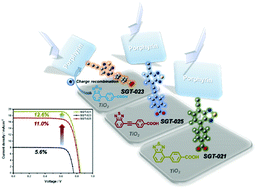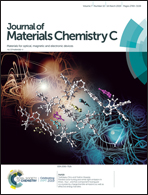Molecular design and synthesis of D–π–A structured porphyrin dyes with various acceptor units for dye-sensitized solar cells†
Abstract
Two porphyrin sensitizers, SGT-023 and SGT-025, were synthesized through acceptor structural engineering. SGT-023 was designed by replacing the commonly used benzothiadiazole (BTD) unit in the well-known platform of D-porphyrin-triple bond-BTD-acceptor sensitizers (e.g., SM315 and SGT-021) with a pyridothiadiazole unit as a stronger electron-withdrawing group. As for SGT-025, an additional ethynylene bridge was inserted into the acceptor part of the well-known skeleton of D-porphyrin-triple bond-BTD-acceptor sensitizers. The impact of the auxiliary acceptors on the optical, electrochemical, and photovoltaic properties was investigated and compared with a benchmark dye, SGT-021, developed by our group. Consequently, both porphyrin sensitizers could red-shift the absorption range and downshift the lowest unoccupied molecular orbital (LUMO) energy level, which was supposed to achieve higher light harvest efficiency (LHE). Under standard global AM 1.5G solar light conditions, SGT-025 attained a relatively high maximum power conversion efficiency (PCE) of 11.0%, which was slightly lower than that of the reference dye SGT-021 (12.6%), and a moderate PCE of 5.6% was obtained by SGT-023. The main reason is the lower charge collection efficiency, which can be attributed to the tilted dye adsorption mode on TiO2. This may allow for faster charge recombination which eventually leads to lower Jsc, Voc and PCE.

- This article is part of the themed collection: 2019 Journal of Materials Chemistry C Most Popular Articles


 Please wait while we load your content...
Please wait while we load your content...